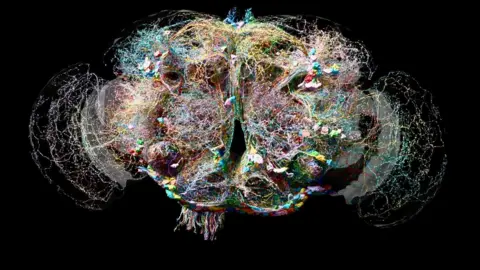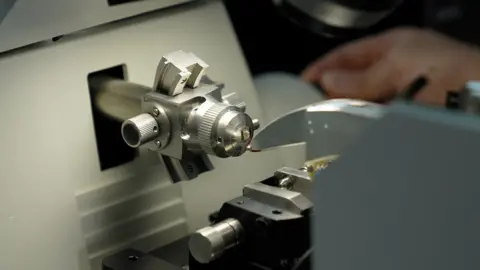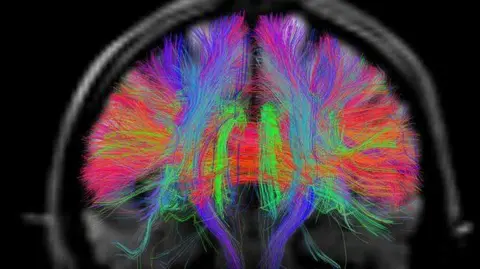 MRC/Nature
MRC/NatureThey can walk, hover and the males can even sing love songs to woo mates – all this with a brain that’s tinier than a pinhead.
Now for the first time scientists researching the brain of a fly have identified the position, shape and connections of every single one of its 130,000 cells and 50 million connections.
It’s the most detailed analysis of the brain of an adult animal ever produced.
One leading brain specialist independent of the new research described the breakthrough as a “huge leap” in our understanding of our own brains.
One of the research leaders said it would shed new light into “the mechanism of thought”.
Dr Gregory Jefferis, of the Medical Research Council’s Laboratory of Molecular Biology (LMB) in Cambridge told BBC News that currently we have no idea how the network of brain cells in each of our heads enables us to interact with each other and the world around us.
“What are the connections? How do the signals flow through the system that can let us process the information to recognise your face, that lets you hear my voice and turn these words into electrical signals?
“The mapping of the fly brain is really remarkable and will help us get a real grasp of how our own brains work.”
We have a million times as many brain cells, or neurons, than the fruit fly which was studied. So how can the wiring diagram of an insect brain help scientists learn how we think?
The images the scientists have produced, which have been published in the journal Nature, show a tangle of wiring that is as beautiful as it is complex.
Its shape and structure holds the key to explaining how such a tiny organ can carry out so many powerful computational tasks. Developing a computer the size of a poppy seed capable of all these tasks is way beyond the ability of modern science.
Dr Mala Murthy, another of the project’s co-leaders, from Princeton University, said the new wiring diagram, known scientifically as a connectome, would be “transformative for neuroscientists”.
“It will help researchers trying to better understand how a healthy brain works. In the future we hope that it will be possible to compare what happens when things go wrong in our brains.”
That is a view backed by Dr Lucia Prieto Godino, a group leader in brain research at the Francis Crick Institute in London, who is independent of the research team.
“Researchers have completed the connectomes of a simple worm which has 300 wires and a maggot which has three thousand, but having a complete connectome of something with 130,000 wires is an amazing technical feat which paves the way for finding the connectomes for larger brains such as the mouse and maybe in several decades our own.”
The researchers have been able to identify separate circuits for many individual functions and show how they are connected.
The wires involved with movement for example are at the base of the brain, whereas those for processing vision are towards the side. There are many more neurons involved in the latter because seeing requires much more computational power.
While scientists already knew about the separate circuits they did not know how they were connected together.
Why are flies so difficult to swat?
Other researchers are already using the circuit diagrams, for example to work out why flies are so difficult to swat.
The vision circuits detect which direction your rolled up newspaper is coming from, and they pass on the signal to the fly’s legs.
But crucially, they send a stronger jumping signal to the legs facing away from the object of their imminent demise. So you could say they jump away without even having to think – literally faster than the speed of thought.
This finding may explain why we lumbering humans seldom squash flies.
 Gwyndaf Hughes/BBC News
Gwyndaf Hughes/BBC NewsThe wiring diagram was made by slicing up a fly brain using what is essentially a microscopic cheese grater, photographing each of the 7,000 slices and digitally putting them altogether. Then the Princeton team applied artificial intelligence to extract the shapes and connections of all the neurons. But the AI wasn’t perfect – the researchers still had to fix over three million mistakes by hand.
This in itself was a technical tour de force, but the job was only half done. The map on its own was meaningless unless there was a description of what each wire was supposed to do, according to Dr Philipp Schlegel, who is also from the Medical Research Council’s Laboratory of Molecular Biology.
“This data is a bit like Google Maps but for brains: the raw wiring diagram between neurons is like knowing which structures correspond to streets and buildings.
“Describing the neurons is like adding the names for streets and towns, business opening times, phone numbers, reviews, etc. to the map. You need both for it to be really useful.”
 BBC News
BBC NewsThe fly connectome is available to any scientist that wants to use it to guide their research. Dr Schlegel believes that the world of neuroscience will see “an avalanche of discoveries in the next couple of years” thanks to this new map.
A human brain is so much larger than the fly’s, and we don’t yet have the technology to capture all the information about its wiring.
But the researchers believe that perhaps in 30 years it may be possible to have a human connectome. The fly brain, they say, is a start of a new, deeper understanding of how our own minds work.
The research has been conducted by a large international collaboration of scientists, called the FlyWire Consortium.



